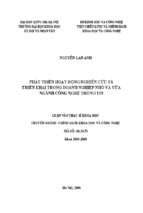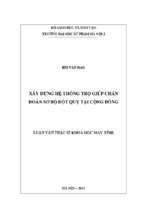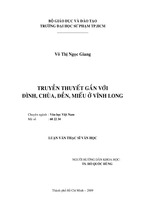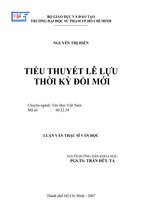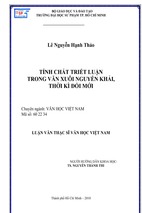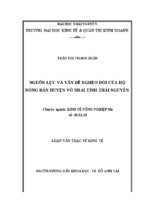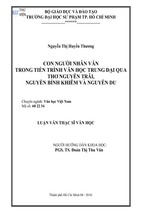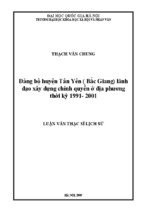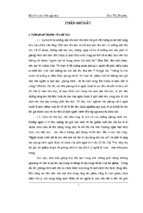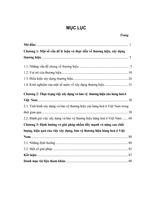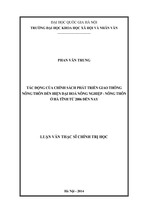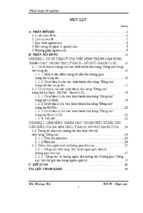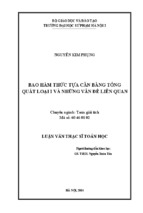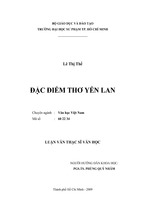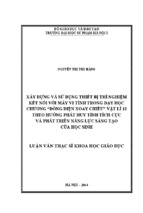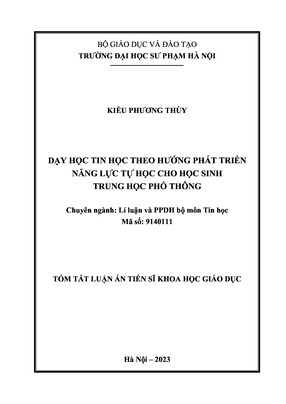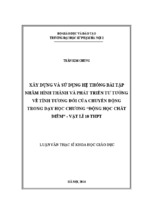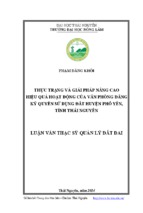This thesis focuses on the similarities and differences in the speech act of comforting among students in American and Vietnamese cultures. The objectives of the present study are to investigate: (i) what topics Vietnamese and American students suggest comforting in their culture, (ii) what comforting strategies Vietnamese and American students use in the situations studied, (iii) what and how socio-cultural factors; namely gender and relationship affect the choice of Vietnamese and American students’ comforting strategies in the situations studied. Topics and strategies realized for comforting are analyzed with data taken from two questionnaires for the Vietnamese and the English students. The first type of questionnaire is Metapragmatic one which was used to explore the appropriate situations’ topics for comforting in two subjects’ cultures and to test the validity and reliability of the situations’ topics. The second questionnaire based on discourse completion task which was used to elicit some forms of comforting from native students of American English and Vietnamese. The results of the DCT were collected from 15 AES and 22 VNS and their responses were classified into eight comforting strategies with the type of quantitative analysis. The results gave out significant differences as well as similarities in the use of topics and strategies between AES and VNS across two situations. Besides, the socio-cultural factors of relationship and gender did have more or less influence on the preference of topics and strategies for comforting peers in which the influence of the relationship is greater than the effect of gender. Therefore, being aware of pragmatic competence is of great importance in cross-cultural communication
VIETNAM NATIONAL UNIVERSITY, HANOI
UNIVERSITY OF LANGUAGES AND INTERNATIONAL STUDIES
FALCULTY OF ENGLISH LANGUAGE TEACHER EDUCATION
----------
GRADUATION PAPER
COMFORTING AMONG STUDENTS IN AMERICAN
ENGLISH AND VIETNAMESE- AS SEEN FROM
INTERCULTURAL COMMUNICATION
Supervisor: Do Thi Mai Thanh,
M.A.
Student’s name: Doan Ngoc Anh
Course: QH08.F1.E5
Ha Noi, May 2012
ĐẠI HỌC QUỐC GIA HÀ NỘI
TRƯỜNG ĐẠI HỌC NGOẠI NGỮ
KHOA SƯ PHẠM TIẾNG ANH
----------
KHÓA LUẬN TỐT NGHIỆP
LỜI AN ỦI GIỮA SINH VIÊN
TRONG TIẾNG VIỆT VÀ TIẾNG ANH MỸDƯỚI GÓC ĐỘ GIAO TIẾP ĐA VĂN HÓA
Giáo viên hướng dẫn: Th.s Đỗ Thị Mai Thanh
Sinh viên: Đoàn Ngọc Anh
Khóa: QH2008.F1.E5
Hà Nội, 5/2012
ACCEPTANCE PAGE
I hereby state that I: Doan Ngoc Anh in group 08.1.E5, being a candidate for the
degree of Bachelor of Arts (TEFL) accept the requirements of the College relating to
the retention and use of Bachelors Graduation Paper deposited in the library.
In terms of these conditions, I agree that the origin of my paper deposited in the
library should be accessible for the purposes of study and research, in accordance with
the normal conditions established by the librarian for the care, loan or reproduction of
the paper.
DOAN NGOC ANH
2nd May 2012
ACKNOWLEDGEMENTS
I would like to express my deepest gratitude to my supervisor, M.A Do Thi Mai
Thanh, for her useful guidance, insightful comments, and considerable
encouragements to complete this thesis.
I wish to express my special thanks to all my lecturers in Vietnam National
University, Hanoi for their precious assistance, scholarly knowledge and
enthusiasm.
Great deals appreciated go to the contribution of all my friends for their
assistances in my data collection.
I would also want to send my appreciation to all the research participants. Without
their valuable opinions and ideas on the questionnaires, the research would not
have been accomplished.
Last but not least, I would like to express my indebtedness to my parents, my
cousins and my best friends who have given me constant support and love during
the completion of the thesis.
Doan Ngoc Anh
i
ABSTRACT
This thesis focuses on the similarities and differences in the speech act of
comforting among students in American and Vietnamese cultures. The objectives
of the present study are to investigate: (i) what topics Vietnamese and American
students suggest comforting in their culture, (ii) what comforting strategies
Vietnamese and American students use in the situations studied, (iii) what and
how socio-cultural factors; namely gender and relationship affect the choice of
Vietnamese and American students’ comforting strategies in the situations studied.
Topics and strategies realized for comforting are analyzed with data taken
from two questionnaires for the Vietnamese and the English students. The first
type of questionnaire is Metapragmatic one which was used to explore the
appropriate situations’ topics for comforting in two subjects’ cultures and to test
the validity and reliability of the situations’ topics. The second questionnaire based
on discourse completion task which was used to elicit some forms of comforting
from native students of American English and Vietnamese. The results of the DCT
were collected from 15 AES and 22 VNS and their responses were classified into
eight comforting strategies with the type of quantitative analysis.
The results gave out significant differences as well as similarities in the use
of topics and strategies between AES and VNS across two situations. Besides, the
socio-cultural factors of relationship and gender did have more or less influence on
the preference of topics and strategies for comforting peers in which the influence
of the relationship is greater than the effect of gender. Therefore, being aware of
pragmatic competence is of great importance in cross-cultural communication.
ii
TABLE OF CONTENTS
* Acknowledgements ……………………………………………………………. i
* Abstract ………………………………………………………………………... ii
* Table of contents………………………………………………………………. iii
* List of abbreviations …………………………………………………………... v
* List of tables ……………………………………………………………........... vi
* List of figures and illustrations………………………………………………... vii
PART I: INTRODUCTION………………………….………………………..... 1
1. Rationale ...…………………………………………………………………...... 1
2. Aims of the study ……………………………………………...…………….… 2
3. Significance of the study………………………………………….………..….. 2
4. Scope of the study ……………………………………………………….......... 3
5. Structure of the study …………………………………………………………. 3
PART II: DEVELOPMENT…………………………………..………….…….. 5
CHAPTER 1: LITERATURE REVIEW………………………..……………. 5
1.1.
Speech acts……….…………………………………………………….... 5
1.2.
Comforting ………………….…………..……………………………….. 6
1.2.1. Definition of comforting ………………………………………….. 6
1.2.2. Comforting as a speech act ………………………………………... 6
1.2.3. Socio-cultural factors affecting comforting ……………………….. 8
1.3.
Comforting and discourse strategy ...…………...……………………… 9
CHAPTER 2: METHODOLOGY ………………………………………........ 14
2.1. Research questions………………………………………………………….. 14
2.2. Data collection instrument …………………………………………………. 14
2.3. Content of the questionnaires ……………………………………………… 15
2.4. Selection of subjects……………………………………………………….. 16
iii
2.5. Data collection procedure…………………………………………………... 16
2.6. Data analysis……………………………………………………………….. 17
CHAPTER 3: FINDINGS AND DISCUSSION………………….…………... 18
3.1.
3.2.
Overall advisable topics and use of strategies for comforting……..… 18
3.1.1.
Overall advisable topics for comforting………………………….. 18
3.1.2.
Overall use of strategies for comforting………………………….. 19
Use of comforting topics and strategies- as seen from socio-cultural
factors …………………………………………………………………………... 21
3.2.1. Relationship……………………………………………………...….. 21
3.2.1.1. Advisable topics for comforting by relationship………………... 21
3.2.1.2. Choice of comforting strategies by relationship in situation 1.... 22
3.2.1.3. Choice of comforting strategies by relationship in situation 2…...26
3.2.2. Gender...…………………………………………………………….. 31
3.2.2.1. Advisable topics for comforting by gender ……………………. 31
3.2.2.2. Choice of strategies by gender in situation 1 ………………….. 32
3.2.2.3. Choice of strategies by gender in situation 1 ……………….….. 35
3.3. Discussion ………………………………………………………….…… 38
3.3.1. Overall use of comforting topics and strategies ……………….…… 38
3.3.2. Factor of relationship ………………………………………….…… 38
3.3.3. Factor of gender …………………………………………….……… 39
PART III: CONCLUSION …………………………………………….……... 41
1. Summary of the findings ……………………………………………….. 41
2. Implication for CCC ……………………………………………………. 41
3. Recommendation for further study …………………………………….. 43
REFERENCES
APPENDICES
iv
LIST OF ABBREVIATIONS
AES: American English students
CCC: Cross cultural-communication
DCT: Discourse completion task
FEA: Face enhancing act
H:
Hearer
MPQ: Metapragmatic questionnaire
S:
Speaker
VNS: Vietnamese students
v
LIST OF TABLES
Table 3.1. Frequency of preferred comforting topics for AES and VNS ……… 18
Table 3.2. Frequency of preferred strategies for AES and VNS ………………..20
Table 3.3. Frequency of advisable topics for comforting by relationship ………21
Table 3.4. Frequency of strategies by relationship in the love split-up
situation………………………………………………………………………….22
Table 3.5. Frequency of preferred strategies by relationship in the death-of-lovedone situation………………………………………………………………………27
Table 3.6. Frequency of advisable topics for comforting by gender……………..31
Table 3.7. Frequency of preferred strategies by gender in love-split-up
situation………………………………………………………………………….32
Table 3.8. Frequency of strategies by gender in death-of-loved-one situation….35
vi
LIST OF FIGURES
Figure 3.1. Frequency of preferred comforting topics for AES and VNS………19
Figure 3.2. Frequency of overall strategies for AES and VNS………………….20
Figure 3.3. Frequency of strategies for close friends in the love split-up
situation………………………………………………………………………….23
Figure 3.4. Frequency of strategies for acquaintances in the love split-up
situation…………………………………………………………………………. 24
Figure 3.5. Frequency of strategies by nodding acquaintance in the love-split up
situation…………………………………………………………………………. 25
Figure 3.6. Frequency of strategies by close friends in the death-of-loved-one
situation…………………………………………………………………………. 28
Figure 3.7. Frequency of strategies by acquaintances in the death-of-loved-one
situation…………………………………………………………………………. 29
Figure 3.8. Frequency of strategies by nodding acquaintances in death-of-lovedone situation…………………………………………………………………….. 30
Figure 3.9. Frequency of strategies by same sex in the love split-up situation…..33
Figure 3.10. Frequency of strategies by opposite sex in the love split-up
situation………………………………………………………………………….34
Figure 3.11. Frequency of strategies by same sex in the death-of-loved-one
situation………………………………………………………………………….. 36
Figure 3.12. Frequency of strategies by opposite sex in the death-of-loved-one
situation………………………………………………………………………….. 37
vii
PART I: INTRODUCTION
1. RATIONALE
It goes without saying that language plays an important role in communication
among human beings; it is not only used to communicate but also to maintain and
convey culture and cultural ties. Likewise, culture also has a significant influence on
the ways in which language is used pragmatically. As the soil, however rich it may be,
cannot be productive without cultivation, so the mind without culture can never
produce good fruit – Seneca. In another word, using language without the cultural
knowledge leads to produce the ineffective messages however rich the language
people have.
With this significance of language usage within certain cultures, one can see
that learning a new language involves the learning of a new culture (Allwright &
Bailey 1991). However, teachers and learners of English in Vietnam still focus on the
development of linguistic competence – lexis, grammatical rules, vocabulary, and
pronunciation with little attention to oral skills and even less to cultural aspect. As a
result, even possibly producing grammatically well-formed utterances, learners may
experience unwanted culture shock, and communication breakdown when running into
a real and particular context of situation. Besides, with the development of society as
well as the process of globalization nowadays, the need for communicating with the
native speakers is increasing dramatically. Therefore, teaching and learning pragmatic
and cultural competence as well as the differences and similarities between the two
cultures is really important for learners to use the target language appropriately and
avoid misunderstandings, offenses and communicative breakdowns.
In terms of aspects of language, speech acts are considered the most closely
related to culture, which attracted a considerable number of researchers; and various
cross cultural studies of speech acts such as thanking, requesting, complementing, etc.
were carried out. However, little attention has been paid to the speech act of
1
comforting though it is used frequently in daily life. Actually, people find it hard to see
someone they care about go through pain or difficulty. Many people would like to help
the person feel better and provide comfort but do not know what to say or worry they
may say and do the wrong thing and even make matters worse. In such sensitive
situations, even the brightest persons seem to be at a loss for words. Therefore, a study
on the similarities and differences in comforting in American English and Vietnamese
cultures through verbal cues is believed to be of great importance and significance.
For all reasons stated, a close look at the speech act of comforting in
communication among students would be taken. This will be conducted with the title:
“COMFORTING AMONG STUDENTS IN AMERICAN ENGLISH AND
VIETNAMESE- AS SEEN FROM INTERCULTURAL COMMUNICATION”
2. AIMS OF THE STUDY
The study aims is:
(i) To explore advisable topics for comforting among American and Vietnamese
students in American English and Vietnamese culture.
(ii) To examine comforting discourse strategies employed by Vietnamese and
American students under the influence of relationship.
(iii)
To examine comforting discourse strategies employed by Vietnamese and
American students under the influence of gender.
3. SIGNIFICANCE OF THE STUDY
As the reasons stated in the previous part, teaching and learning English as a
foreign or second language requires the pragmatic and cultural competence to achieve
the communicative approach. Therefore, the comparative study on the speech act of
comforting is really necessary to improve teaching and learning methods in Vietnam.
Moreover, with the increasing demand for interacting and communicating with
native American especially among students, being aware of the differences as well as
the similarities between two cultures will help learners and speakers especially
2
students in a new environment to use the target language appropriately and avoid
misunderstandings, offenses and communicative breakdowns.
It is hoped that the investigation into the ways of comforting among
Vietnamese and American students will contribute to the success in the real-life
communication.
4. SCOPE OF THE STUDY
The study focuses on verbal communication; paralinguistic and non- verbal
factors are not discussed here.
The data are collected by conducting survey questionnaires by the author
herself. Besides, the data analysis is mainly taken into account of strategies based on
what is collected from two situations of case study in which the act of comforting
occurs among three kinds of students relations: close friend, classmate, and
schoolmate relations.
In addition, it must be noted that different groups of age of the interlocutors
may affect the speaker’s speech patterns. However, the informants in this study are
Vietnamese and American students at the age from 18-25 to keep the number of DCT
items to a minimum. The number of items would have doubled if the range of age is
widened, which would have put a greater strain on the subjects to complete DCT.
Finally, because of the limitations of time and materials, this study is unable to
discuss the ways the addresses respond when they are comforted.
In the view of these limitations, the study can only be regarded as a preliminary
study and any conclusions are tentative.
5. STRUCTURE OF THE STUDY.
As for the design of the study, it is composed of three main parts:
Part I - Introduction - introduces the rationale, aims, significance, and scope of the
study.
Part II - Development - consists of three chapters. They are:
3
-
Chapter 1 (Literature review) introduces the key theoretical concepts that
the study based on: Speech acts, comforting, and discourse strategies.
-
Charter 2 (Methodology) mentions the research questions, data collection
instruments, selection of subjects, data collection procedures and data
analysis.
-
Chapter 3 (Findings and discussions) presents the results of the study in
terms of advisable topics and the use of comforting strategies in order to
answer the research questions.
Part III – Conclusion – summarizes the most important findings of the study,
recommend for CCC as well as proposes some suggestions for further research.
4
PART II: DEVELOPMENT
CHAPTER 1: LITERATURE REVIEW
This chapter reviews the theories and literature relevant to the topic under
investigations in the present study. The first section mentions speech acts, the second
section reveals comforting, comforting as a speech act and factors affecting
comforting. The final section offers the discourse strategies.
1.1 . SPEECH ACTS
The notion of speech acts dates back the British philosopher of language John
Austin (1962). In his very influential work, ‘How to do things with words’, Austin
defines speech acts as the actions performed in saying something or actions performed
using language. In fact, when speaking, we perform certain linguistic actions such as
giving reports, making statements, asking questions, giving warnings, making
promises, comforting and so on. In other words, speech acts are all the acts we
perform through speaking – all the things we do when we speak.
Austin (1962) distinguished the theory of speech acts between three kinds of
acts, namely locutionary, illocutionary, and perlocutionary then. Of these, a
locutionary act is the act of saying something in the full sense of “say”. An
illocutionary act is the one of using the sentence to perform a particular function; and
a perlocutionary act is the one of producing some kinds of effects that is produced by
means of saying something. Among above three kinds of acts, the illocutionary act
which Austin later termed “speech act” is the core interest of Austin as well as of other
pragmatists (Levinson, 1983).
In addition, Yule (1997) believed that actions performed via utterances are
generally called speech acts and, in English, are commonly given more specific labels
such as requesting, apologizing, offering, etc. The circumstances in which actions are
performed to communicate are generally speech events- activities in which participants
use language to interact in some conventional way to reach some outcome.
5
According to Searle (1969), language is a part of action theory, and speech act
are those verbal acts such as promising, threatening and requesting that are performed
in speaking. Indeed, American usually says “How are you doing” and Vietnamese say
“where are you going?” to perform an act of greeting; or “It’s hot here” can be used to
perform acts of statement or request and so forth. It is also argued that speech acts are
culture-specific and the manner of performing them is governed by social norms which
differ from one community to another.
Although many theorists have studied the speech act theory, generally all of
them share the common idea that speech act are the actions that are involved when one
says something.
1.2. COMFORTING
1.2.1. Definition of comforting
Comforting can be broadly defined as an act of making somebody who is
worried or unhappy feel better by being kind and sympathetic towards them (see The
Oxford Advanced Learner’s Dictionary vs. comfort and comforting). Sharing the same
ideas, Longman dictionary also defines that ‘comforting is to make someone feel less
worried, unhappy, or upset, for example by saying kind things to them or touching
them’. It can also be defined in another way such as comforting is to give moral or
strength to, to soothe someone in time of affliction or distress, to lessen pain or to ease
or relieve them physically and mentally (see The Free dictionary, Thesaurus by Farlex)
1.2.2. Comforting as a speech act
In terms of speech act theory, the speech act of comforting can be classified as
the kind of directive as the speaker wants the hearer to calm down, to feel better or to
overcome the pain.
E.g. A person comforting someone after a break up may say ‘Forget him and
find another one!’
In addition, comforting can also be seen as a Commissives in the sense that S
offers spending time with the H or promises to help the H out, solving the problem or
6
just entertaining the H. In short, the S wants to commit himself to taking an action to
help the H out of the current situation.
E.g. ‘I’m here to listen to you’
Besides, in another aspect, comforting can be categorized into an expressive
type of speech act, especially when the S wants to express his feelings to show
sympathy to the H’s problem.
E.g. ‘I’m terribly sorry you’re in so much pain’
Moreover, comforting also functions as a representative speech act as the S tries
to point out the excuses or reasons to explain why it is pointless for the H to feel sad or
disappointed.
E.g. ‘He’s just a jerk; he doesn’t deserve you anymore’
Furthermore, in real-life communication, one remarkable feature of this speech
act is that it is a composite of several different sub-speech acts such as ‘expressing
sympathy’, ‘giving advice’, ‘encouraging’, etc. – to comfort hearers. (Perlocutionary
speech act) (Suzuki, T, 2008)
E.g.: ‘I’m sorry, but, maybe I’ll be sure to come next time’: This saying
comprises two sub-speech acts: apologizing and encouraging.
Sharing the same idea with Toshihico Suzuki, Bui Anh Duong (2008) also
stated that for different context, both American and Vietnamese people tended to use
different strategies to comfort someone and employed at least two strategies for all
situations given.
Besides of speech act types, the speech act of comforting is supposed to be an
FEA (face-enhancing act) for H (cf. Kerbat-Orecchioni, 1997: p.14), because S use
this speech act to give advice, offer support, or make a proposal, etc., for the hearers’
benefits.
Moreover, comforting messages display high person-centeredness as they
recognize the other’s feelings by helping the other to articulate those feelings,
7
elaborating reasons why the other are experiencing those feelings, and assisting the
other to see how those feelings fit in a broader context (See Burleson, 2003a).
Burleson and Goldsmith (1998) argued, highly person-centered comforting
messages are beneficiary and effective forms of support because they help to lessen
the emotional stress of others by creating a supportive conversational environment and
encourage sense-making about the upsetting experience.
In short, it can be concluded that comforting is a very complex speech act, and
it is inclined to be performed by means of other strategies. Also, it is a composite of
several different sub-speech acts with the aims of enhancing face for H.
1.2.3. Socio-cultural factors affecting comforting
Firstly, the factors of social statues and social distances have a remarkable
influence on the use of comforting strategies and internal modification. According to
Bui Thi Anh Duong (2008), American and Vietnamese people used a greater number
of strategies in high-power and equal –power situations than in the low-power ones.
Moreover, social statuses also have influence on the frequency of use of internal
modification in the act of comforting. Speakers of unequal power in both Vietnamese
and English were prone to use more down graders than upgraders when comforting.
(see Bui Thi Anh Duong, 2008)
Secondly, age is one of the factors affecting the act of comforting. According to
Suzuki (2010), the children used rather limited strategies to perform the speech act of
comforting than the adult’s. The common strategies that young informants aged from
7-10 attempted to comfort their communicative partners are apologizing, encouraging,
offering something, and soothing while the adult use various of strategies such as
giving sympathy, offering solutions, giving advice, or encouraging, giving praises of
H, criticizing H’s opponent, wishing for better results, offering support, etc.
Relationship is another factor contributing to comforting. Some research has
examined how aspects of one’s relationship influence the quality of comforting one
gives (Burleson, 2003). For example, Costin and Jones (1992) found that people
8
expend more effort comforting close friends than they do strangers. Besides,
comforting may be used as a maintenance behavior in close relationships (David et al.,
2009). In fact, comforting bears some similarities to the maintenance behavior of
positivity, which includes being supportive of one’s partner (Stafford & Canary,
1991).
David et al. (2009) also indicates that people may alter their comforting
strategies, depending on their perceptions of equity within romantic relationships.
People seek to balance perceptions of supportiveness using comforting strategies.
Individuals who recognize themselves as having greater wealth or status than their
partner may feel that their role in the relationship is similar to that of a parent or
guardian. If individuals perceive that their status is an important contribution they
make to the relationship, they may enjoy being able to effectively comfort their
partners. Burleson (1994) notes that sophisticated comfort givers often feel better
about themselves after providing comfort. It may be that providing effective
comforting is a particularly positive experience for those who feel their status creates
an obligation to take care of their partners.
Therefore, socio-cultural factors such as social status, social distance, age and
relationship did have a significant influence on comforting and comforting strategies.
1.3.
COMFORTING AND DISCOURSE STRATEGIES
As mentioned in previous part 1.2.2, the speech act of comforting can be seen a
composite of sub-speech acts or different types of speech act. Therefore, the following
comforting strategies were categorized basing on functions of speech act types, and the
primary research in the related field.
Category A: Expressing sympathy
According to Oxford Advanced Learners’ Dictionary, ‘sympathize’ is to feel
sorry for somebody; to show that you understand and feel sorry about somebody's
problems. In terms of speech act types, ‘expressing sympathy’ can be seen as a
expressive speech act. Here are some illustrations:
9
English
Vietnamese
I’m so sorry to hear this.
Tôi rất tiếc về chuyện này
I wish there was something I could
Anh mong có thể nói được điều gì đó
say to ease your pain.
để giảm đi nỗi đau của em lúc này.
I know this is hard and you’re
upset.
Tớ biết điều này thật khó khăn và ấy
cũng rất buồn.
I understand that you miss your
family and friends.
Chị biết em nhớ gia đình và bạn bè
lắm.
Category B: Reassuring H’s feelings
In this strategy, S wants to calm H down and lift H’s spirit up at the same time.
According to Bui Anh Duong (2008), it is also one way of indicating that S and H are
cooperators and thus to imply knowledge of H’s wants and willingness to fit one’s
own wants with them.
English
Vietnamese
Don’t worry
Đừng lo!
Don’t be sad
Đừng buồn nữa!/ Buồn làm gì!
Cheer up!
Vui lên nào!
Calm down!
Bình tĩnh!
Fighting!/ Go on!/ Move on!
Cố lên nhé!
Category C: Soothing
Soothing can be understood as an act of saying or doing something that make H
to feel calmer and less worried, upset, or angry (Longman Dictionary of Temporary
English). Utterances of this type are thought to relieve H’s hurt or sad feeling.
10
- Xem thêm -

